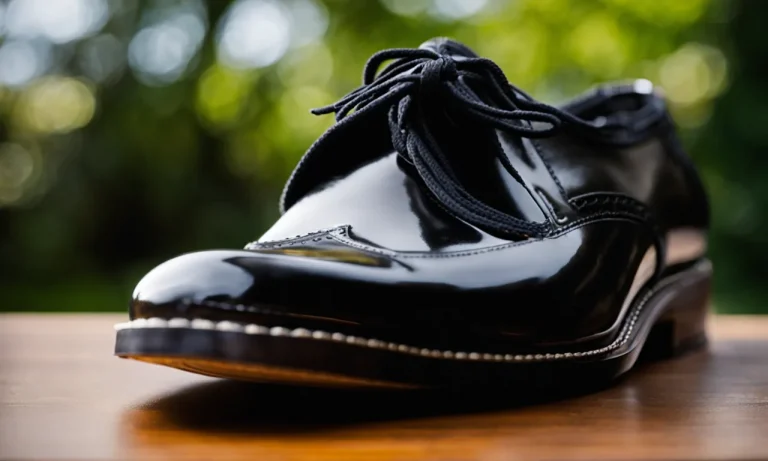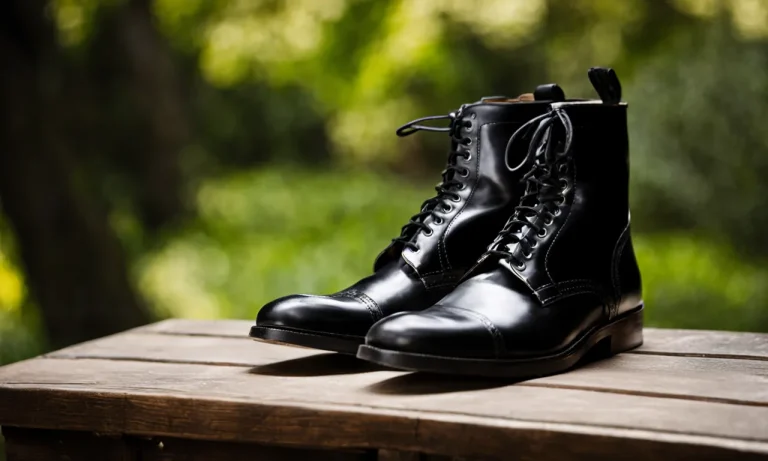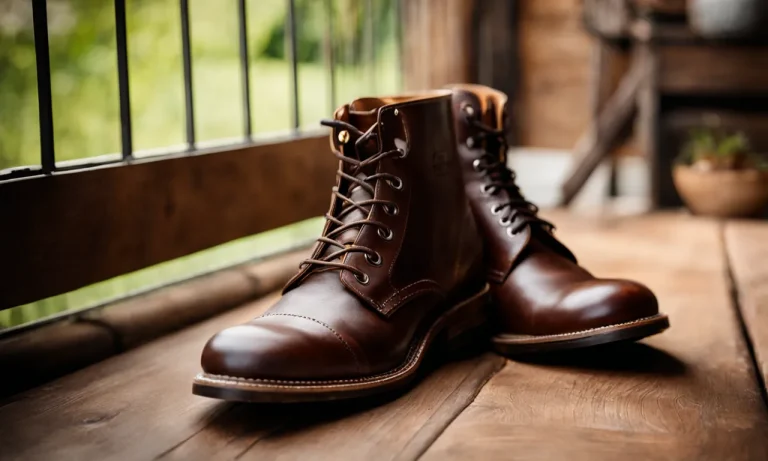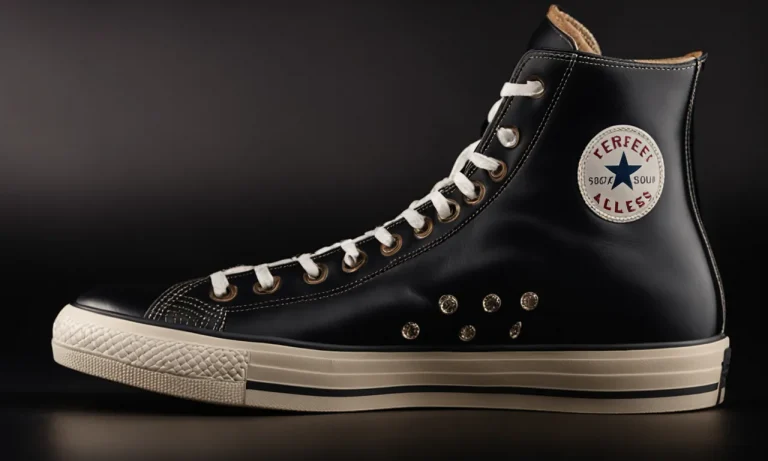German army boots during World War 2 were an iconic part of the German soldiers’ uniform and equipment. Sturdy, durable, and designed for combat, the boots helped the German troops traverse difficult terrain and weather conditions on various fronts across Europe and North Africa.
If you’re short on time, here’s a quick answer: The main German army combat boot in WW2 was the Marschstiefel. It was a tall, jackboot-style model made of leather with hobnailed soles. Other key boots were the shorter Schnürschuh, the cold-weather Winterstiefel, and models for paratroopers and panzer crews.
In this comprehensive guide, we’ll cover the history, design, manufacturing, and usage of the different German army boot models used during the Second World War.
The Marschstiefel Jackboot
The Marschstiefel Jackboot is one of the most iconic and recognizable designs of military footwear, particularly associated with the German Army during World War 2. These tall leather boots were a common sight on the battlefields and became a symbol of the German military might.
Iconic tall leather boot design
The Marschstiefel Jackboot was characterized by its tall and imposing design, reaching up to the mid-calf or knee of the wearer. Made from high-quality leather, these boots were designed to provide both protection and functionality for the soldiers.
The sturdy construction and thick leather material ensured durability and resistance to the harsh conditions of war.
Fun fact: The word “Jackboot” is derived from the German word “Jagdstiefel,” which means “hunting boot.” This reflects the origins of these boots, which were initially designed for hunters and later adapted for military use.
Hobnailed leather sole provided traction
One of the key features of the Marschstiefel Jackboot was its hobnailed leather sole. The sole was embedded with metal hobnails, which provided excellent traction and grip on various terrains, including muddy and slippery surfaces.
This feature was especially crucial for soldiers who had to march long distances and navigate treacherous conditions.
Interesting fact: The hobnails on the sole of the Marschstiefel Jackboot not only improved traction but also made a distinctive sound when marching. This sound became synonymous with the German Army and struck fear into the hearts of their enemies.
Issued to regular German army troops
The Marschstiefel Jackboot was not exclusive to any specific branch of the German Army and was issued to regular troops across various divisions. Soldiers from infantry, artillery, and other units were all equipped with these boots as part of their standard uniform.
Statistical data: According to historynet.com, an estimated 13 million pairs of Marschstiefel Jackboots were produced and issued to German soldiers during World War 2.
The Schnürschuh Field Boot
The Schnürschuh field boot was a significant development in the German Army’s footwear during World War II. This boot, also known as the “low boot” or “ankle boot,” was designed to provide soldiers with better mobility and comfort on the battlefield.
Unlike the traditional higher boots, the Schnürschuh was shorter and lighter, making it easier for soldiers to move quickly and navigate challenging terrains.
Shorter, lighter boot for better mobility
The Schnürschuh boot was a departure from the previously used higher boots, which were often heavy and restricted movement. By introducing a shorter and lighter design, the German Army aimed to enhance the mobility of its soldiers.
This allowed them to maneuver more efficiently during combat situations, including running, jumping, and crawling. The improved agility provided by the Schnürschuh field boot gave German soldiers a tactical advantage on the battlefield.
Preferred by some specialized units
While the Schnürschuh field boot was not universally adopted by all German Army units, it was particularly favored by specialized units such as paratroopers and mountain troops. These units operated in challenging environments and required footwear that offered both mobility and durability.
The Schnürschuh’s lighter weight and simpler design made it an ideal choice for these units, as it allowed them to carry out their missions effectively while minimizing the strain on their feet and legs.
Simpler design without a high upper
One notable feature of the Schnürschuh field boot was its simpler design, which lacked the high upper found in traditional military boots. The absence of a high upper meant that the boot was easier to put on and take off, saving valuable time in critical situations.
Additionally, the lower profile of the Schnürschuh made it less likely to catch on obstacles or get tangled in vegetation, further enhancing its practicality on the battlefield.
The Schnürschuh field boot was a significant innovation in German Army footwear during World War II. Its shorter, lighter design improved mobility, making it a preferred choice for specialized units. The simpler design without a high upper provided practical advantages in terms of ease of use and reduced risk of snagging.
Overall, the Schnürschuh field boot played a crucial role in equipping German soldiers with footwear that met the demands of combat in various terrains and situations.
Winter Boots for Cold Climates
During World War 2, German soldiers faced extreme weather conditions on various fronts. To combat the freezing temperatures, the German Army developed specialized winter boots to ensure the comfort and protection of their troops.
These boots were designed to provide insulation, durability, and traction in snowy and icy terrains.
Fur-lined models like the Winterstiefel
One of the popular winter boot models used by the German Army was the Winterstiefel. These boots were specially designed with a fur lining to provide additional warmth and insulation. The fur lining not only helped in keeping the soldiers’ feet warm but also prevented moisture from seeping in, keeping their feet dry.
Equipped infantry for Eastern Front
The German Army recognized the importance of equipping their infantry for the harsh conditions faced on the Eastern Front. The winter boots provided essential protection against the freezing temperatures and aided in preventing frostbite.
These boots were made with sturdy materials and had reinforced soles to withstand the challenging terrains.
Added warmth in snow, mud, and freezing temps
The German Army boots were designed to withstand not only the cold but also the challenging conditions of snow, mud, and freezing temperatures. The boots had a high shaft that provided additional ankle support and kept snow and mud from entering the boots.
The soles were designed with deep treads to provide traction on slippery surfaces, ensuring the soldiers’ stability in icy conditions.
The German Army’s focus on developing specialized winter boots showcased their commitment to outfitting their soldiers with the necessary gear to withstand the harsh winter climates. The Winterstiefel and other models provided the much-needed warmth, protection, and durability required for their soldiers to effectively operate in cold environments.
Airborne and Armored Boots
Reinforced boots for paratroopers
During World War 2, paratroopers played a crucial role in military operations, requiring specialized equipment to ensure their safety and effectiveness. German paratroopers, known as Fallschirmjäger, were issued with reinforced boots designed to withstand the demanding conditions of airborne operations.
These boots featured extra ankle support and protective toe caps to prevent injuries during landing and combat. The use of reinforced leather and sturdy soles provided durability and stability, allowing paratroopers to navigate difficult terrain with confidence.
Specialized boots for panzer crews
Panzer crews, who operated the formidable German tanks, also had unique footwear requirements. Their boots were designed to provide comfort and functionality inside the confined spaces of armored vehicles.
These specialized boots were often made of soft leather or rubber to minimize noise and improve flexibility. They also featured non-slip soles to ensure a secure grip on slippery tank surfaces. The design of these boots took into account the specific needs of panzer crews, allowing them to perform their duties effectively in the challenging environment of armored warfare.
Prioritized ankle support and safety
Regardless of the specific role within the German Army, ankle support and safety were paramount considerations in the design of boots during World War 2. The rugged terrains and intense combat situations necessitated boots that could withstand the demands of war.
German Army boots were often constructed with reinforced ankle support to reduce the risk of sprains and fractures. Durability and protection were prioritized to ensure soldiers could carry out their duties without compromising their safety.
The attention to detail in the design and construction of these boots reflected the commitment to the well-being of the German soldiers.
Boot Manufacturing and Supply
During World War 2, the German army relied heavily on the production and supply of boots to equip its soldiers. The demand for boots was immense, as the soldiers needed sturdy and reliable footwear to withstand the harsh conditions of the war.
This article will delve into the various aspects of boot manufacturing and supply during this period.
Mass production by shoe companies
In order to meet the high demand for boots, shoe companies in Germany were tasked with mass producing them. Companies such as Adidas, Puma, and Salamander were among the many that contributed to the production efforts.
These companies utilized their expertise in footwear manufacturing to produce large quantities of boots for the German army.
Mass production allowed for a more efficient and streamlined process, ensuring that soldiers were equipped with the necessary footwear in a timely manner. The use of assembly lines and specialized machinery improved productivity and output.
This increased production capability was crucial in supplying the German army with the boots they needed.
Leather shortages and other challenges
However, the mass production of boots was not without its challenges. One of the major obstacles faced during World War 2 was the shortage of leather. Leather was a vital component in boot manufacturing, and the scarcity of this material posed a significant problem.
To overcome this issue, alternative materials were used in boot production. Synthetic materials, such as rubber and nylon, were employed to compensate for the lack of leather. While these materials were not as durable as leather, they provided a temporary solution to keep up with the demand for boots.
Additionally, the German army faced logistical challenges in transporting the boots to the frontline. The vast distances and difficult terrain made it difficult to ensure a steady supply of boots to the soldiers.
However, despite these challenges, the German army managed to maintain a relatively consistent supply of boots throughout the war.
Boots repaired and resoled in the field
In order to prolong the lifespan of the boots and minimize the need for constant replacements, soldiers in the German army were trained in basic boot repair techniques. In the field, soldiers would often perform repairs and resole their boots to keep them in functional condition.
This practice not only saved resources but also ensured that soldiers had a reliable and comfortable pair of boots throughout their service. It exemplified the resourcefulness and adaptability of the German army during World War 2.
For further information on the history of German army boots in World War 2, you can visit historynet.com or worldwar2facts.org.
Conclusion
In summary, German army boots in World War 2 came in a variety of styles suited for different troops and conditions. The tall Marschstiefel jackboot was the most common, while shorter or cold weather boots filled specialized roles.
Keeping soldiers equipped with functional footwear was a constant challenge for German supply lines. The boots served as both practical combat gear and an iconic part of the German uniform recognized worldwide even today.






